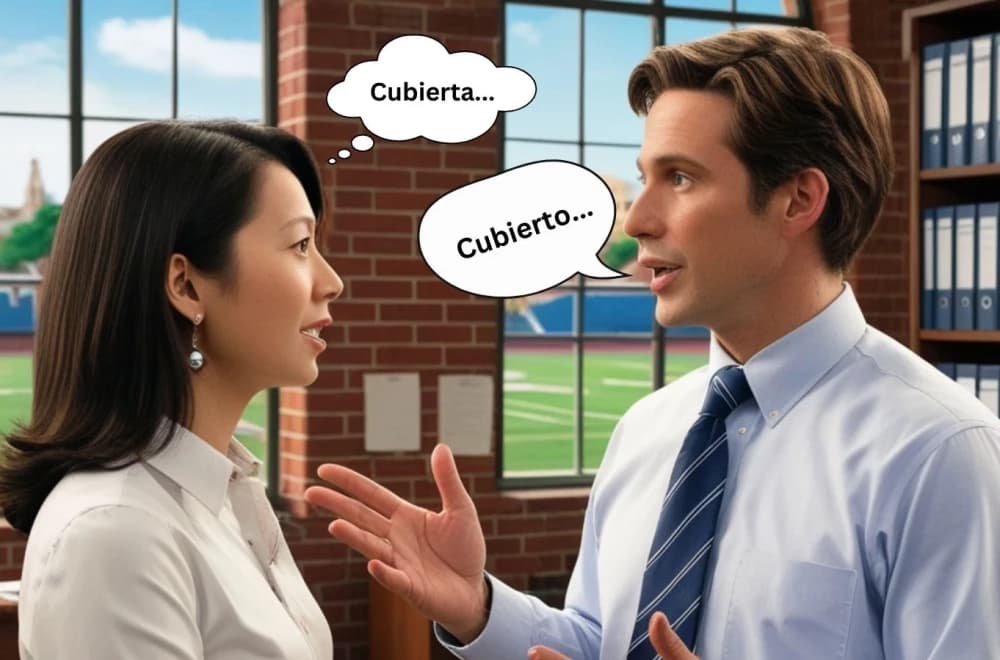A deep dive into how gender and endings in Spanish nouns can change meanings entirely.
The Spanish language often surprises learners with its nuanced word pairs, where the gender and ending of a noun can entirely transform its meaning. This week, we explore cubierto (masculine) and cubierta (feminine)—two words that demonstrate this linguistic peculiarity beautifully.
The Masculine 'Cubierto': Tools, Settings, and Shelter
The word cubierto primarily refers to items associated with meals or coverings. Here's how it is commonly used:
-
Cutlery and Dining:
- Un cubierto denotes an individual piece of cutlery, like a fork (tenedor), knife (cuchillo), or spoon (cuchara).
- Los cubiertos refers to a complete set of flatware.
Examples:
- Recogió sin prisa el plato y los cubiertos usados.
He unhurriedly picked up the used plate and cutlery. - Necesito un cubierto para la ensalada.
I need a utensil for the salad.
Additionally, un cubierto can describe the full place setting, including plates, glasses, and napkins:
- La cesta de picnic lleva platos, mantel y seis cubiertos.
The picnic hamper contains plates, a tablecloth, and settings for six.
-
Cost Per Head:
In dining contexts, un cubierto also refers to the cost per person or per head at an event:- La celebración, que incluía una cena a 20 euros el cubierto, fue todo un éxito.
The celebration, which included dinner at 20 euros a head, was a great success.
- La celebración, que incluía una cena a 20 euros el cubierto, fue todo un éxito.
-
Shelter or Cover (Literal and Figurative):
- Ponerse a cubierto means to take shelter, often from harsh weather.
- Figuratively, it implies protection from danger or risk:
- La violencia del aguacero no le permitió pensar en otra cosa que en ponerse a cubierto.
The heavy downpour meant she could think of nothing but getting under cover. - El progreso de la medicina no nos pone a cubierto de nuevos virus.
Advancements in medicine don’t keep us safe from new viruses.
- La violencia del aguacero no le permitió pensar en otra cosa que en ponerse a cubierto.
The Feminine 'Cubierta': Covers, Decks, and Tyres
Shifting to the feminine cubierta, the focus moves from tools to coverings and surfaces:
-
Covers and Roofs:
Una cubierta often means a cover, protective layer, or roof:- Las mesas tenían una cubierta plástica transparente encima del mantel.
The tables had a transparent plastic cover over the tablecloth. - Había un dibujo de una calavera en la cubierta.
There was a picture of a skull on the cover.
- Las mesas tenían una cubierta plástica transparente encima del mantel.
-
Decks of a Ship:
- La cubierta refers to the deck on a boat or ship, offering a breezy spot for passengers:
- Los pasajeros disfrutan de barbacoas en la cubierta del barco.
The passengers enjoy barbecues on the deck of the boat.
- Los pasajeros disfrutan de barbacoas en la cubierta del barco.
- La cubierta refers to the deck on a boat or ship, offering a breezy spot for passengers:
-
Tyres (or Tires):
In automotive contexts, cubierta can mean a tyre or tire:- Unas cubiertas que se adaptan a la cantidad y tipo de nieve.
Tyres that adapt to the type and quantity of snow.
- Unas cubiertas que se adaptan a la cantidad y tipo de nieve.
Grammar Note: Agreement is Key
Always ensure that adjectives and articles agree with the noun in gender and number:
- Cubiertos limpios – Clean cutlery
- Una cubierta protectora – A protective cover
- La venta de cubiertas nuevas y recauchutadas – The sale of new and remoulded tyres
Did You Know?
The word cubierto also serves as the irregular past participle of the verb cubrir (to cover). It can be used adjectivally to mean "covered":
- El humo del incendio había cubierto la capital.
Smoke from the fire had covered the capital. - Su escritorio estaba cubierto de carpetas y libros.
His desk was covered with folders and books.
Final Thought:
Understanding how gender affects meaning in Spanish is vital for mastering the language. Stay tuned for next week’s exploration of another intriguing pair!







